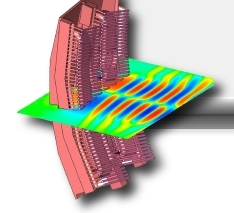 The theoretical work at LPP-ERM/KMS focuses for a large part on ICRF heating. A big effort goes into the design of the ITER ICRH antenna. The antenna model is simulated by use of various codes. The commercial code CST MWS ® handles complex 3D antenna geometry, but can not simulate a true plasma load; only loads consisting of a medium with constant diagonal dielectric tensor can be represented. The in-house developed ANTITER code is used for quick plasma loading calculations but cannot handle complex geometries. Detailed 3D geometries with plasma loading are simulated with the TOPICA code, in collaboration with Politecnico di Torino. The combination of these three codes enables our design team to optimize the electrical properties of the ITER antenna. An effort is also made to improve the TOPICA code by including RF sheath effects into the code.
The theoretical work at LPP-ERM/KMS focuses for a large part on ICRF heating. A big effort goes into the design of the ITER ICRH antenna. The antenna model is simulated by use of various codes. The commercial code CST MWS ® handles complex 3D antenna geometry, but can not simulate a true plasma load; only loads consisting of a medium with constant diagonal dielectric tensor can be represented. The in-house developed ANTITER code is used for quick plasma loading calculations but cannot handle complex geometries. Detailed 3D geometries with plasma loading are simulated with the TOPICA code, in collaboration with Politecnico di Torino. The combination of these three codes enables our design team to optimize the electrical properties of the ITER antenna. An effort is also made to improve the TOPICA code by including RF sheath effects into the code.
Apart from antenna design codes, LPP-ERM/KMS also has in-house developed codes to describe the absorption of the RF waves. The full-wave code CYRANO, which includes second order finite Larmor radius corrections, has been coupled to the quasi-linear Fokker-Planck code BATCH. Self-consistent studies of wave propagation and absorption are now possible.
Other theoretical studies are done to understand the effect of the dynamic ergodic divertor on the radial conductivity in TEXTOR.